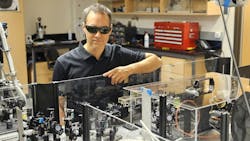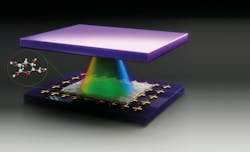Terahertz metasurface optical cavity ‘light trap’ creates quantum states
A group of scientists led by Professor Jean-Michel Ménard at the University of Ottawa in Canada has shown that THz metasurfaces—which can be fabricated at large scale and relatively low cost—are a robust and efficient platform to hybridize molecules with THz light (see video). And their platform offers an alternative to the standard cavity design to explore and harness the unique properties of strongly coupled quantum states.
Perhaps even more importantly, strongly coupled quantum states that involve molecules offer the possibility to control fundamental building blocks of life.
To create a metasurface optical cavity “light trap” within a two-dimensional (2D) plane, Ménard’s Ultrafast Terahertz Spectroscopy group teamed up with Claudiu Genes’ Cooperative Quantum Phenomenon research group at the Max Planck Institute for the Science of Light in Germany, and Iridian Spectral Technologies, an Ottawa-based company that specializes in optical filters. When sugar-coated (with glucose), the group’s metasurface triggers a strong interaction between THz light and glucose molecules.
Strong coupling between light and molecules
The group’s work centers on the concept that strong coupling between light and an ensemble of molecules requires three conditions: “A tight spatial confinement of the light, a high number of molecules, and a high likelihood that molecules can absorb and reemit a photon trapped inside the cavity,” explains Ménard.
Glucose has a strong and narrow absorption line centered at a frequency of 1.43 THz, which satisfies the last condition. Knowing this allows the group to design a complementary high-quality optical resonator (cavity/metasurface) to trap this THz radiation while compacting as many glucose molecules as possible on this surface.
To ensure high-density glucose deposition, they developed a spray coating technique akin to how cars are painted. “The main difference? We use a solution of glucose instead of paint color,” Ménard says. “Under precise experimental conditions, the molecules couple to the electromagnetic mode trapped within the metasurface to create hybrid states. And these states called ‘polaritons’ aren’t uniquely matter nor light—their quantum superposition gives them unique properties.”
A new optical cavity ‘light trap’ design
Since pioneering work began within this realm during the 1990s, research into strong light-matter interactions has largely relied on one type of optical device with an optical cavity that consists of two mirrors facing each other, with a semiconductor material sandwiched in between.
By replacing the semiconductor material with organic molecules, the regime of strong light-matter coupling can fundamentally modify the properties of molecules—and it can lead to surprising effects such as a change in chemical reaction rates. This potential to gain control of chemical reactions has far-reaching applications for many fields, particularly health and medicine.
It motivated the group’s quest to create a new type of cavity to efficiently trap THz light, which is located within the deep infrared region of the electromagnetic spectrum and can strongly interact with molecules.
While experimenting with cavities and metasurfaces, a revelation hit the group: the two can be combined. Crafting a cavity out of a metasurface and positioning a flat metallic mirror—so they face each other—above it substantially enhances the strength of the light-matter interaction by about 2x compared to a standalone planar cavity.
“This discovery encouraged us to explore the physics of why we saw such an improved enhancement and we discovered these hybrid cavity/metasurface architectures can enhance the electric field strength of light within them in a way that combines the benefits of both cavities and metasurfaces,” says Ahmed Jaber, a Ph.D. student in Ménard’s group. “Our results show that hybrid architectures facilitate stronger hybrid states.”
What goes into their optical cavity’s simple design? First, a metasurface is crafted from a planar array of metallic crosses, which each have a length of 60 µm and are periodically separated by 100 µm. A thin film of glucose (an organic material) then gets sprayed onto this surface. A mirror can be positioned facing this metasurface to ensure light gets trapped to form a highly localized photonic mode, which increases the THz interaction with glucose.
It's important to note: no precise alignment is needed to trap the light, thanks to the geometry of the metasurface’s metallic pattern. And the group’s platform is essentially plug-and-play, which means other organic materials can be used in it to create a range of different quantum systems with new properties.
“One of the biggest challenges that must be overcome is to gain a better understanding of the fundamental light coupling mechanism to an ensemble of molecules,” Ménard points out. “Is the light affecting one molecule at a time or all of them simultaneously?”
Another challenge is “identifying families of molecules that, when hybridized with light, feature dramatically modified physical or chemical properties,” Ménard says. “Hopefully, such molecules can play a key role in environmental, health, or energy transport applications to enable promising applications to improve our lives.”
Prior to the past two decades, the THz region was largely unexplored by the scientific community because techniques for its generation and detection were inefficient, and optical components—lenses, polarizers, etc.—were difficult or cost-prohibitive to fabricate.
“A lot of our group’s effort went into developing efficient techniques for THz spectroscopy,” says Ménard. “With our collaborators, we also developed 2D planar surfaces, or metasurfaces, to select specific spectral components, modify the spatial distribution, and increase the local intensity of THz light.”
Modified chemical reaction applications ahead?
One of the most intriguing applications of strong light-matter coupling with molecules is exploring modified chemical reactions. “When light-matter coupling is fundamentally altering the vibrational bonds of a molecule, it should have a defined effect on chemical reactions that involve these bonds,” says Ménard.
While there’s been early research into the field of polaritonic chemistry, it’s still new. Its potential is tremendous because polaritons can create entirely new degrees of freedom for chemistry. And the timeline for related applications is likely more than five years out, but based on growing interest of the scientific community it may at least end up being less than 10 years.
“The next step is to apply our design methodology of polaritonic devices for THz optical frequencies toward fundamental physics applications,” says Ménard. “This includes, for example, exploring the modification of chemical reaction rates, properties like electrical conductivity, or temperature-induced phase transitions within materials.”
FURTHER READING
A. Jaber et al., Nat. Commun., 15, 4427 (2024); https://doi.org/10.1038/s41467-024-48764-6.
About the Author
Sally Cole Johnson
Editor in Chief
Sally Cole Johnson, Laser Focus World’s editor in chief, is a science and technology journalist who specializes in physics and semiconductors.




